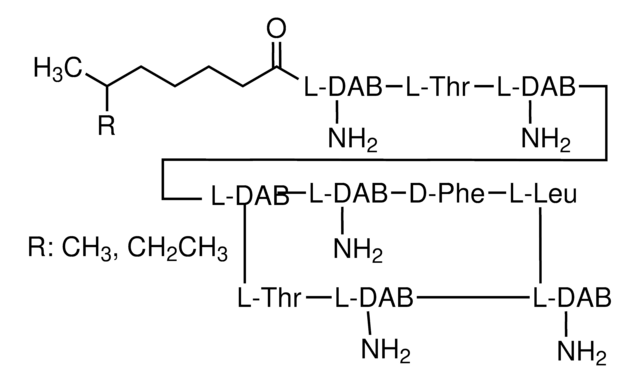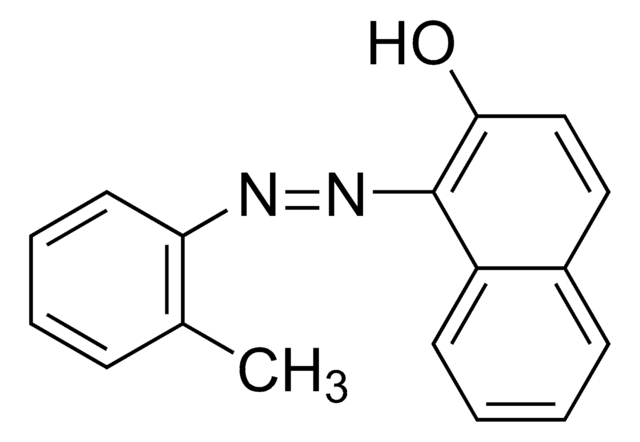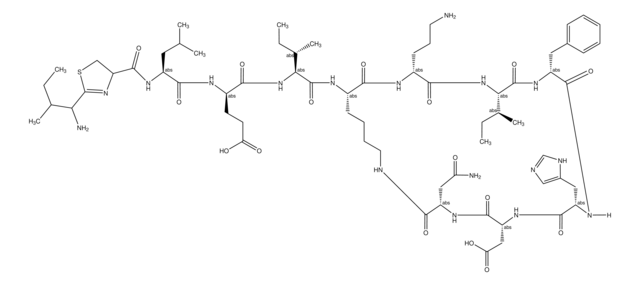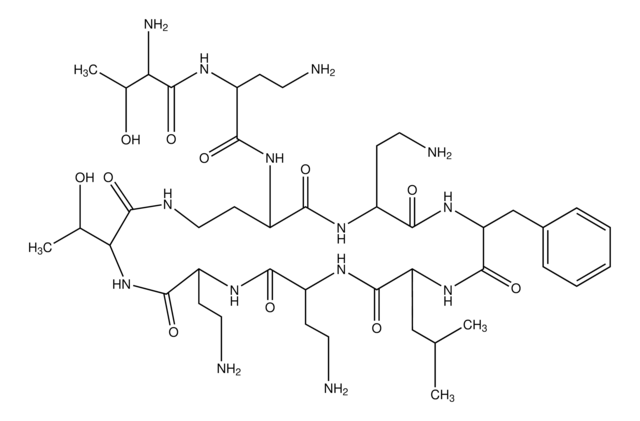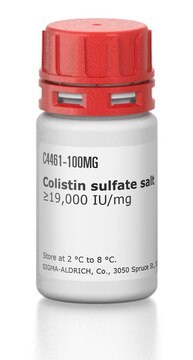81271
Polymyxin B solution
1 mg/mL in H2O, analytical standard
About This Item
Polecane produkty
klasa czystości
analytical standard
Poziom jakości
stężenie
1 mg/mL in H2O
metody
HPLC: suitable
gas chromatography (GC): suitable
spektrum działania antybiotyku
Gram-negative bacteria
Gram-positive bacteria
fungi
Zastosowanie
pharmaceutical (small molecule)
format
single component solution
Tryb działania
cell membrane | interferes
temp. przechowywania
2-8°C
InChI
1S/C48H82N16O13.H2O4S/c1-27(2)24-37-47(76)59-32(11-19-52)41(70)56-31(10-18-51)43(72)61-35(14-22-65)39(68)54-21-13-34(45(74)57-33(12-20-53)44(73)64-38(48(77)63-37)25-28-6-4-3-5-7-28)60-42(71)30(9-17-50)58-46(75)36(15-23-66)62-40(69)29(8-16-49)55-26-67;1-5(2,3)4/h3-7,26-27,29-38,65-66H,8-25,49-53H2,1-2H3,(H,54,68)(H,55,67)(H,56,70)(H,57,74)(H,58,75)(H,59,76)(H,60,71)(H,61,72)(H,62,69)(H,63,77)(H,64,73);(H2,1,2,3,4)
Klucz InChI
HNDFYNOVSOOGDU-UHFFFAOYSA-N
Szukasz podobnych produktów? Odwiedź Przewodnik dotyczący porównywania produktów
Opis ogólny
Zastosowanie
Działania biochem./fizjol.
Mode of Resistance: The activity of Polymyxin B sulfate is inhibited by iron(II), Co(II), Mn(II) and Magnesium ions. Polymyxin B may also be incompaitible with other microbial agents, including amphoterecin, cephalothin sodium, cephasolin sodium and heparin sodium.
Antimicrobial Spectrum: Has bactericidal action on most gram-negative bacilli, including E. Coli and on most fungi and gram-positive bacteria.
Uwaga dotycząca przygotowania
Kod klasy składowania
12 - Non Combustible Liquids
Klasa zagrożenia wodnego (WGK)
WGK 2
Temperatura zapłonu (°F)
Not applicable
Temperatura zapłonu (°C)
Not applicable
Środki ochrony indywidualnej
Eyeshields, Faceshields, Gloves
Choose from one of the most recent versions:
Masz już ten produkt?
Dokumenty związane z niedawno zakupionymi produktami zostały zamieszczone w Bibliotece dokumentów.
Nasz zespół naukowców ma doświadczenie we wszystkich obszarach badań, w tym w naukach przyrodniczych, materiałoznawstwie, syntezie chemicznej, chromatografii, analityce i wielu innych dziedzinach.
Skontaktuj się z zespołem ds. pomocy technicznej